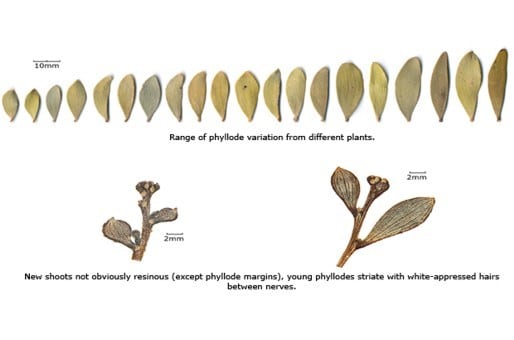Acacia mulganeura (variant 1)
WATTLE
Acacias of Australia
Family
Fabaceae
Notes
This variant is described and illustrated by Maslin & Reid (2012: 241–243) under A. mulganeura.
The relationships between A. mulganeura (variants 1 and 2) and the typical A. mulganeura require further study. Resolution of these relationships has thus far been constrained by the relative paucity of flowering material and the lack of genetic information. Generally speaking A. mulganeura (variant 1) superficially resembles short phyllode morphotypes of the typical variant while A. mulganeura (variant 2) superficially resembles long phyllode morphotypes of the typical variant. The most obvious differences between the two variants and typical A. mulganeura appears to be the degree of resinosity of the youngest 1–3 phyllodes on new shoots. In typical A. mulganeura these youngest phyllodes are very resinous by a discrete covering of resin that normally obscures the underlying nervation and white hairs (reddish glandular hairlets are often visible within this resin matrix). In the two variants on the other hand, the resin is less well-developed so that on the youngest 1-3 phyllodes the longitudinal nerves with white appressed hairs in between are normally visible (only rarely obscured by a dense covering of white appressed hairs). These red-brown nerves are normally only slightly resinous. As noted by Maslin & Reid (l.c.) A. mulganeura (variant 1) has slightly longer sepals than the typical variant; however, as already noted, very little flowering material of either entity has been seen and it is therefore not known how reliable this subtle difference is.
FOA Reference
Flora of Australia Project
Author
B.R.Maslin
This identification key and fact sheets are available as a mobile application:
URL: https://apps.lucidcentral.org/wattle/
© Copyright 2018. All rights reserved.






